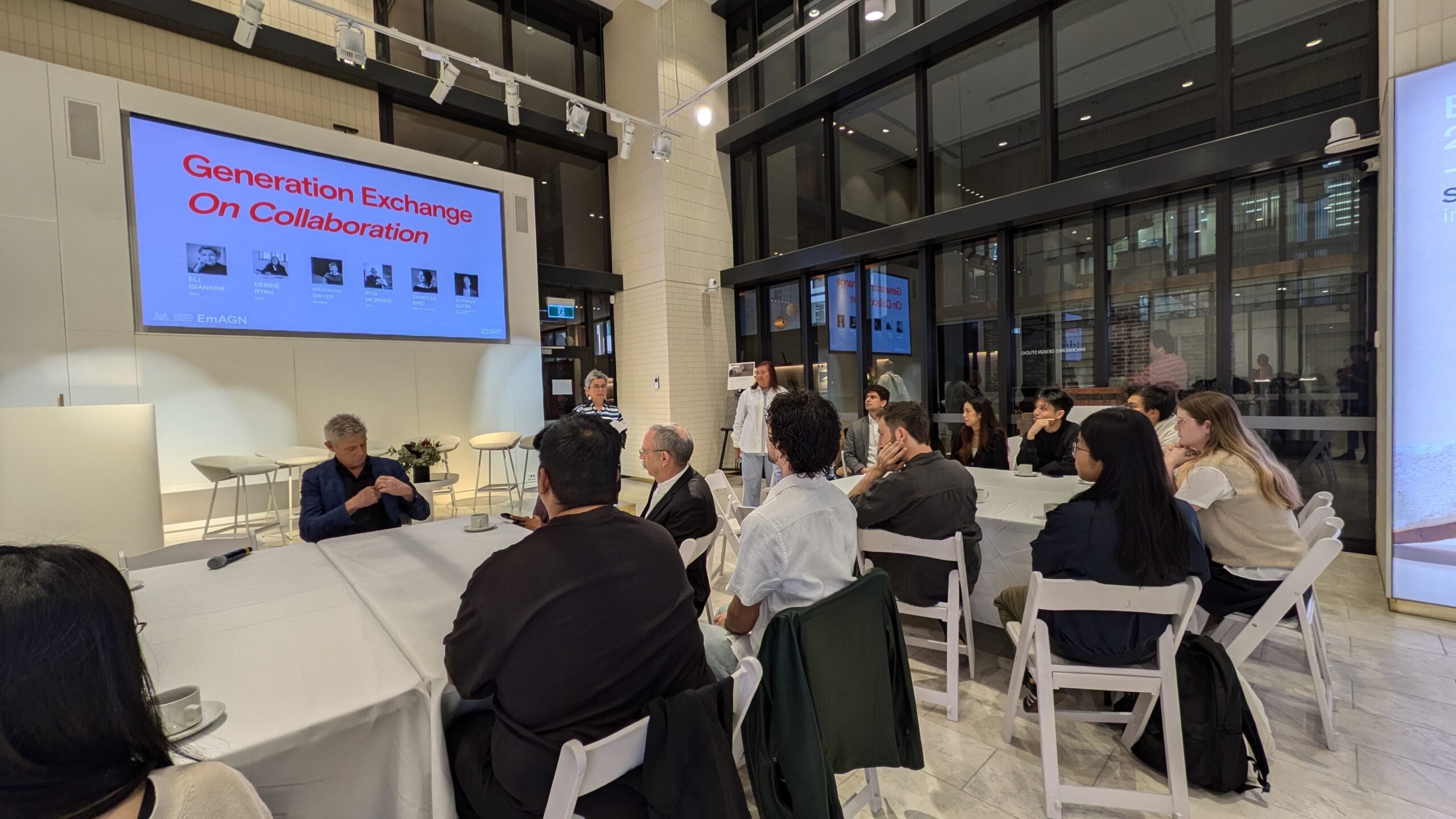Focused on unlearning the concept of ‘the starchitect’, EmAGN’s most recent Generation Exchange event, ‘On Collaboration’, leaned into exploring the value of working together. The morning discussion between various established practitioners reflected on the diverse players involved in delivering a project, and the essential inputs they each bring, forming the very foundations of effective collaboration for better design outcomes. Trisha Karkhanis provides a summary of the key takeaways from the event below.
Known for drawing invaluable knowledge out of established practitioners in the industry, EmAGN’s latest Generation Exchange event invited directors and partners from Mcbride Charles Ryan, Wardle, MGS, and Bird De La Coeur, along with the chair of architectural design at The University of Melbourne, to come together on a Wednesday morning on 12th November and talk all things collaboration. Young architects and graduates gathered at the Brickworks Melbourne Design Studio for the event series, which aimed to pass on knowledge gained by senior professionals from the field onto the next generation. From collaborations within and outside of the studio, the morning was filled with empowering dialogue that provided the attendees with a toolkit for navigating collaborative processes.
1. Collaboration Within a Studio
Collaboration in studios takes many forms. There was much talk around the value in shared commitment – particularly when it comes to problem-solving and deadlines. Director of Melbourne-based practice Mcbride Charles Ryan, Robert McBride noted the benefit of a flat structure being that “everyone knows what’s going on,” coining it as a productive learning environment that extends beyond traditional task allocation. Partner at Wardle, Meaghan Dwyer stressed the importance of practices also selecting individuals that add value to the team, leading the event discussion towards understanding how maximising individual skill sets within a practice can often allow them to emerge stronger as a whole. Co-founder of Bird De La Couer, Vanessa Bird brought a slightly more ‘solutionist’ attitude. “Don’t come to me with problems. Come to me with solutions,” she said, giving individuals the opportunity, and responsibility to think critically towards fast tracking their own growth with a proactive mindset that builds confidence and problem-solving skills.
2. Collaboration With Consultants, Builders and Contractors
Shared ideas, mutual trust, and respect, built through communication, are the glue that unifies project goals. “Always explain yourself and cut the jargon,” claimed Eli Giannini, Director of MGS Architects. Through encouraging the audience to be clear when engaging with their project teams, she stressed how creating an even playing field can lead to ideas being shared between a collective, resulting in everyone feeling more invested. Collaboration may not be easy in today’s tech-driven world, however, workshops and sketch sessions were noted as useful tools that have the ability to bring project teams closer together.
Bates also underlined the importance of caution against generalisations when dealing with professional relationships. “You can’t label someone as difficult,” he said. He emphasised that what may seem like a challenging personality could often be a difference in perspectives or communication styles, requiring a more thoughtful approach when working together on a project. When struck with difficulties in project teams, the owner of Mcbride Charles Ryan, Debbie Ryan, suggested there is power in reframing challenges: it can often be about changing the question from ‘why did you do this?’ to instead query, ‘have you thought about doing it like this?’
Collaboration often evolves depending on contracts and roles, but as Bates observed, the lack of direct contact with contractors has the ability to hinder great design. “It sounds like compromise, but standing your ground avoids mediocrity,” he said. McBride further emphasised how breaking communication barriers can be beneficial to all, humorously referencing a story where he was explaining brick patterns to a structural engineer using his daughter’s Jenga set.
3. Collaboration Between firms
More recently, many architects that are embracing partnerships are reaping the benefits of learning and growing across complex team structures. Multidimensional teams are growing in demand as they combine skills and perspectives that single firms may not provide alone. Especially in Victoria, collaborative architects are finding they are able to set aside competition for complex projects and create better results for their practices. “Architects know each other well and collaborate when they believe the outcome will be stronger,” explained Bates.
For smaller firms, collaboration offers invaluable opportunities. “Expand the group you work with, especially when you don’t have the expanse or CV,” Bird encouraged. Partnering with larger practices not only builds expertise but also introduces teams to different working cultures, broadening perspectives and delivering varied design solutions.
It was agreed by all that collaboration thrives on learning by osmosis, with panellists highlighting the value of overhearing conversations in open offices. “Hearing how people talk to each other teaches you how collaboration happens,” noted Bird and McBride. Observing senior architects interact with consultants provides many younger practitioners insights into communication and problem-solving. By embracing feedback and staying engaged, early-career architects can secure their booster seat at the table and become valued collaborators from the very beginnings of their careers..
The event left graduates and young architects interrogating where they position themselves while aspiring to earn that seat at the big table one day. For many, collaboration is both a challenge and an opportunity. McBride reassured young professionals that seniors don’t hire assuming you know everything.” He emphasised curiosity, encouraging everyone to ask questions – the more, the better. His greatest tip? “Lean in, take risks, and suggest ideas.”
Panelists:
Meaghan Dwyer – Partner, Wardle
Debbie Ryan – Owner, Mcbride Charles Ryan
Robert McBride – Director, Mcbride Charles Ryan
Vanessa Bird – Co-founder, Bird De La Couer
Donald Bates – Chair of Architectural Design,University of Melbourne
Facilitator:
Eli Giannini – Director, MGS Architects
Writer Bio:
Trisha Karkhanis is a recent RMIT graduate, working as an Architectural Graduate at Particular Architects. Passionate about fostering diversity, she volunteers with organisations like MAPP, where she is part of the editorial team and contributes to their events, initiatives, and projects.
This article was produced by EmAGN Media.

